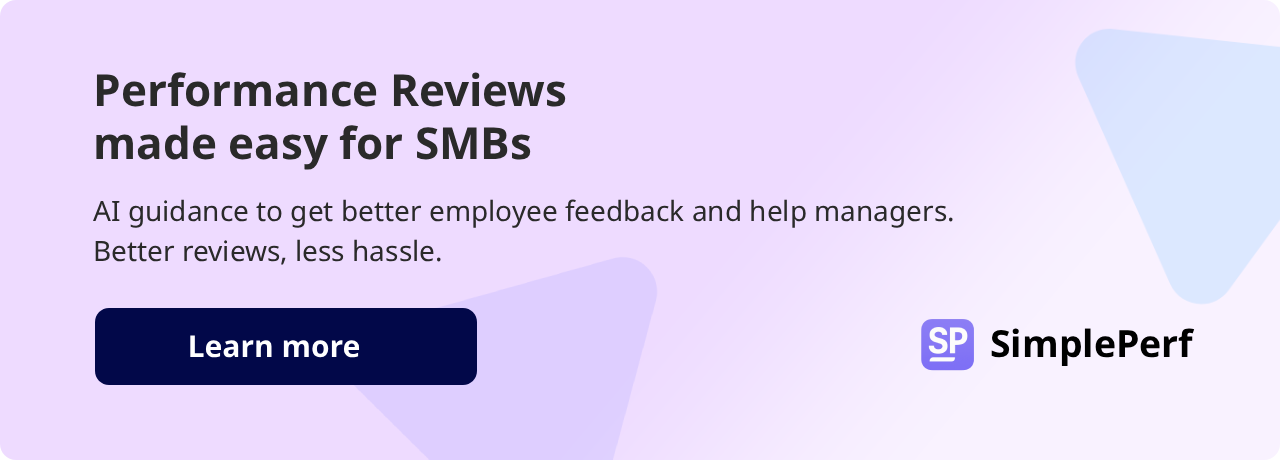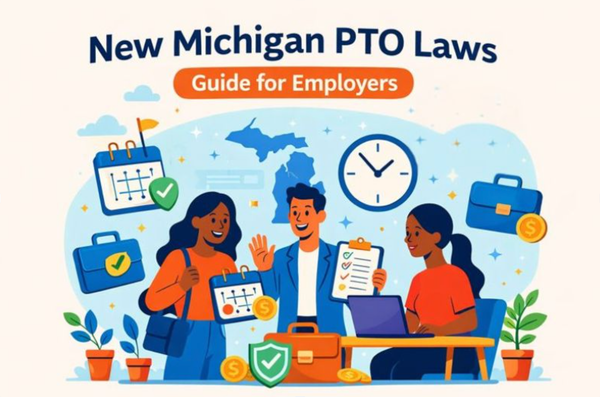Overall Performance Review Comments & Phrases You Can Use
Not easy to know what to say in a performance review. Don't fall in the trap of leaving vague feedback, here are some alternatives.

Employee performance reviews are already awkward enough, even without having to look for the right words at the end. But those closing lines are more important than most people realise, and often they're the only part people remember. So, if you rely on generic praise or vague feedback, you miss the chance to say something that helps.
This article gives you practical performance review comments you can use in employee reviews, split into types, with context for when and how to use them. Whether someone’s doing well, improving, or needs direction, these phrases will help you say something useful and worth remembering.

Why summary comments deserve more thought
Summary comments, or overall performance comments, are often treated like a formality, a sentence or two to wrap things up. But they’re usually the only thing employees remember after the meeting is over. They appear in promotion reviews, performance ratings, and HR files, and over time, they influence someone’s internal reputation (whether they're meant to or not).
When that final comment is vague, recycled, or overly polite, it means less to everyone involved.
What good comments do
A good summary comment serves a purpose, and it's not just a compliment. It:
- Recognises behaviour and outcomes.
- Connects the what with the why, so employees know why the work mattered.
- Looks forward to just as much as it looks back.
With them, you’re helping someone understand how their work fits into the broader scope and how it relates to their own performance and team goals.
What bad comments sound like
You’ve probably seen these a hundred times:
- “Great year, keep it up.”
- “Strong contributor with positive attitude.”
They sound fine just because they're polite. But they’re also empty and don’t say anything specific to help the person grow. Worst of all, they make it look like you, the HR, don't acknowledge hard work.
Here’s how that same idea could sound with a little more thought:
“Led Q3 roadmap planning and delivered on every milestone while mentoring two junior team members. Shows readiness for broader scope.”
That one sentence communicates contribution, leadership, and future potential. It gives the person something they can be proud of or improve upon. You don’t need a long paragraph, just a line or two that says something meaningful.
Now that we’ve got that clear, let’s look at some performance review examples you can use, organised by different performance review phrases and people you’re likely to encounter in any performance review cycle.
1. Phrases that recognise outstanding performance
When someone’s consistently operating at a high level, the last thing you want is a flat, one-size-fits-all compliment. Generic praise like “great work this year” doesn’t show the importance of what they’ve done, and it doesn’t help anyone understand what made their performance exceptional.
With top performers, you should focus on impact, consistency, and ownership. Besides just doing their job, they’re also pushing projects forward, delivering creative solutions or innovative ideas, and raising the bar for team productivity. Your comment should recognise that.
Try:
- “Delivers consistently exceptional results and sets a high bar for the team.”
- “Owns complex projects that require great technical skills from start to finish and anticipates potential issues that could impact team objectives.”
- “Has an important role in strategic decisions and delivers outcomes that show deep technical expertise and exceed expectations.”
- “Regularly earns the trust of peers and leadership through execution and follow-through.”
- “Continues to take on high-impact work with clarity, independence, and measurable results.”
The point here isn’t flattery, but recognition, and saying their high-quality work and innovative solutions stood out for all the right reasons goes a long way in keeping them motivated and moving forward.
2. Phrases that capture reliable work
Every team has a few people who rarely say anything, never miss a deadline, and still keep everything running. Even though they’re not looking for recognition in a collaborative environment, they still deserve it.
When you’re writing a summary for someone like this, you should give them credit for their consistency and accountability. These aren’t the people you have to check in on constantly, but if they can just handle it, you should point that out. It is important for their ongoing professional development.
Try these example phrases:
- “Dependable and focused. Maintains quality even when there are tight deadlines.”
- “Manages daily responsibilities with care, consistency, and minimal oversight.”
- “Consistently supports the team's success and team performance.”
- “Always follows through, even on the small things most people overlook.”
- “Provides steady, reliable support across team efforts and functions without needing direction.”
Don’t underestimate how powerful these comments can be. Just because someone isn’t looking for attention doesn’t mean they're not doing a great job.
People who quietly keep things moving often get missed in review season. Clappy helps you recognise steady contributors casually, without being "in their face". Download Clappy for free and send a recognition to someone you haven’t shouted out in a while.
3. Phrases for pointing out growth areas (without demotivating)
Giving constructive feedback is one of the most complex parts of writing a performance summary. You want to be honest, but you don’t want to demoralise someone or come off vague and unhelpful.
A good growth-focused comment has a balance: it’s direct but respectful, clear without being blunt, and gives the person something they can work on.
This kind of feedback isn’t about character but about behaviour, and more importantly, it’s about what they can do to improve. Someone could be struggling privately, or just plateauing, and your phrasing should make the solution feel realistic and achievable.
Your summary comments for such employees should show specific areas for continuous improvement and, ideally, tie those to a next step or positive intent.
Try:
- “Would benefit from creating clearer priorities and improving time management skills when managing simultaneous deadlines.”
- “Needs to work on follow-through during cross-functional handoffs.”
- “Should continue developing confidence in client-facing communication skills, especially in high-stakes moments.”
- “Could improve consistency by building better weekly planning habits.”
- “Next step is taking a more proactive approach in surfacing blockers during team meetings.”
- “Would grow further by strengthening delegation and trusting peers with execution.”
Avoid:
- “Needs improvement.”
- “Could do better with communication.”
These phrases are vague and can sometimes come off as passive-aggressive. They don't tell the person what to improve or how. If your goal is to give constructive criticism, the comment has to be just as clear as it is honest.

4. Forward-looking comments for potential
When someone is already doing great, a forward-looking comment can be the most motivating thing you write. It tells them you see more in them and that you trust them.
These comments are especially valuable for people in professional growth phases like those taking on more responsibility, building confidence, or starting to influence outside their immediate role. A good forward-facing comment is based on the current employee's performance but points to future opportunity and job satisfaction. It’s a way to frame the plan for them without putting unnecessary pressure on it.
Try:
- “Ready to take on more strategic ownership with continued mentorship.”
- “Poised for growth into a leadership-track role based on performance and initiative.”
- “Next step is developing cross-functional influence to match operational strength.”
- “Has shown potential to guide others and would benefit from small mentorship opportunities.”
- “Well-positioned to lead projects independently with some added support on planning.”
These can be very motivating for the employee because they show that you’re paying attention to the effort they put in.
If feedback only happens once a year, it’s easy for it to feel flat or forced. Performance management software line Clappy can help you normalise everyday recognition, so end-of-year reviews don’t have to carry everything. Add it to your Slack workspace for free.
5. Recognising emerging leadership traits
Leadership isn’t always about a title. Sometimes, it's in the way someone calms a room, takes ownership during chaos, or helps a newer teammate without being asked. These are the early signs of leadership that matter just as much as formal responsibilities, and they should be recognised when they appear.
Calling out these traits in a performance summary not only validates the person’s growth, but it also helps others around them see the difference. Maybe they’re not managing anyone yet, but they’re already influencing how the team functions. That deserves to be noted.
These comments are especially useful for employees getting more responsible informally. People whom others are already turning to, even if it’s not in their job description.
Try:
- “Brings clarity during ambiguity and earns trust from teammates through calm, organised direction.”
- “Often serves as a go-to resource for onboarding and problem-solving support.”
- “Guides team members thoughtfully and models the kind of behaviour we want more of.”
- “Inspires trust and alignment by consistently thinking beyond their own scope.”
- “Demonstrates early leadership skills by proactively stepping in during cross-team blockers.”
When you name leadership early, you give people the confidence that they’re on the right track.
Summary comments to avoid (and what to say instead)
Even well-meaning managers slip into habits that water down their feedback. A vague or overly polite summary might seem harmless, but it can do more harm than good, as it often confuses the person and misses the point.
Here are a few common offenders:
- Too vague: “Great attitude.”
- Too soft: “Could improve in some areas.”
- Too personal: “Has a negative attitude.”
You can imagine that these don’t help the employee understand what worked, what didn’t, or what steps will lead to improved performance.
Instead, you can say this:
- “Brings a consistently collaborative mindset, even when timelines are tight.”
- “Needs to be more proactive in surfacing blockers during weekly check-ins.”
- “Would benefit from clearer documentation to support easier collaboration.”
Good summary comments are respectful, specific, and focused on behaviour, not personality. If you’re going to take the time to give positive feedback, make sure it says something valuable.
What now?
If writing performance evaluations still feels like dragging weight, that’s usually a sign the system’s broken, not the people. A single well-written line can change the way someone sees their work or themselves. But only if it’s specific, timely, and honest.
The phrases in this article aren’t scripts. They’re tools to help you say something that shows the work that’s been done and the direction of employee development.
SimplePerf makes it easy for small teams to run 360 reviews. It helps managers fill their parts and write meaningful feedback leading to higher employee engagement. Set it up for free in just minutes and start building a positive team environment for everyone.





